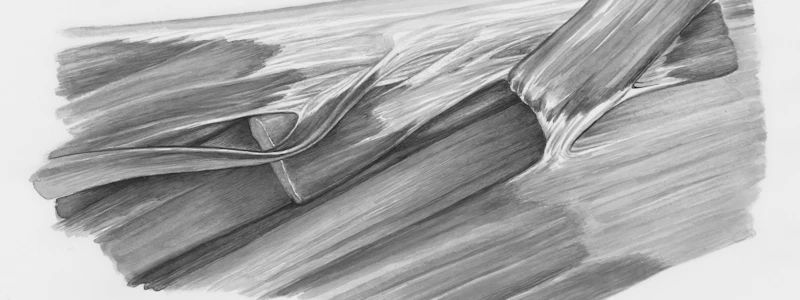Podcast
Questions and Answers
Which type of neck movement involves tilting the head backward?
Which type of neck movement involves tilting the head backward?
- Neck rotation
- Neck flexion
- Neck extension (correct)
- Lateral neck flexion
When referring to unilateral muscle action, which statement is correct?
When referring to unilateral muscle action, which statement is correct?
- Unilateral actions are always associated with neck rotation.
- Only the muscle on one side contracts. (correct)
- It involves muscles of the trunk region only.
- Both left and right muscles contract simultaneously.
What is the correct origin point of the sternal head of the sternocleidomastoid muscle?
What is the correct origin point of the sternal head of the sternocleidomastoid muscle?
- Temporal bone
- Mastoid process
- Medial clavicle
- Manubrium of sternum (correct)
Which of the following muscle regions is NOT part of the erector spinae group?
Which of the following muscle regions is NOT part of the erector spinae group?
Which of these statements about neck rotation is true?
Which of these statements about neck rotation is true?
Which of the following actions is classified as bilateral?
Which of the following actions is classified as bilateral?
What anatomical feature is associated with the insertion of the sternocleidomastoid muscle?
What anatomical feature is associated with the insertion of the sternocleidomastoid muscle?
Which muscle is specifically referred to for its role in neck flexion?
Which muscle is specifically referred to for its role in neck flexion?
What is the primary action of the subclavius muscle?
What is the primary action of the subclavius muscle?
From which anatomical landmark do all muscles originating from the medial epicondyle of the humerus arise?
From which anatomical landmark do all muscles originating from the medial epicondyle of the humerus arise?
Which structure is associated with the bicipital aponeurosis?
Which structure is associated with the bicipital aponeurosis?
What is NOT a function of the anconeus muscle?
What is NOT a function of the anconeus muscle?
Which tubercle is located below the glenoid fossa?
Which tubercle is located below the glenoid fossa?
Which bone feature does NOT articulate with the midshaft of the radius?
Which bone feature does NOT articulate with the midshaft of the radius?
Identify the correct pairing of a muscle and its associated action.
Identify the correct pairing of a muscle and its associated action.
What is the mistake often made regarding the functions of muscles originating from the medial epicondyle?
What is the mistake often made regarding the functions of muscles originating from the medial epicondyle?
What is the common origin for the muscles attached to the lateral epicondyle of the humerus?
What is the common origin for the muscles attached to the lateral epicondyle of the humerus?
Which joints are primarily involved in the movements of the fingers?
Which joints are primarily involved in the movements of the fingers?
What is the term used for the muscles that enable abduction at the dorsal side of the fingers?
What is the term used for the muscles that enable abduction at the dorsal side of the fingers?
Which structure separates the ulna from the radius along the forearm?
Which structure separates the ulna from the radius along the forearm?
The anatomical term 'hypothenar' refers to which part of the hand?
The anatomical term 'hypothenar' refers to which part of the hand?
What is the primary role of the palmar interossei muscles?
What is the primary role of the palmar interossei muscles?
Which of the following phalanges is directly associated with the first metacarpal?
Which of the following phalanges is directly associated with the first metacarpal?
What does the acronym PAD stand for in relation to the muscular functions of the hand?
What does the acronym PAD stand for in relation to the muscular functions of the hand?
Flashcards
Neck Extension
Neck Extension
Movement of the head backward, where the chin points upwards.
Unilateral Muscle Action
Unilateral Muscle Action
Only one side of the muscle contracts, creating movement in a single direction.
Manubrium of Sternum
Manubrium of Sternum
The top part of the breastbone, where the sternocleidomastoid muscle originates.
Erector Spinae Group
Erector Spinae Group
Signup and view all the flashcards
Neck Rotation
Neck Rotation
Signup and view all the flashcards
Bilateral Muscle Action
Bilateral Muscle Action
Signup and view all the flashcards
Mastoid Process
Mastoid Process
Signup and view all the flashcards
Sternocleidomastoid (Flexion)
Sternocleidomastoid (Flexion)
Signup and view all the flashcards
Subclavius Muscle
Subclavius Muscle
Signup and view all the flashcards
Medial Epicondyle
Medial Epicondyle
Signup and view all the flashcards
Bicipital Aponeurosis
Bicipital Aponeurosis
Signup and view all the flashcards
Anconeus Muscle (Function)
Anconeus Muscle (Function)
Signup and view all the flashcards
Infraglenoid Tubercle
Infraglenoid Tubercle
Signup and view all the flashcards
Olecranon (Articulation)
Olecranon (Articulation)
Signup and view all the flashcards
Coracobrachialis Muscle (Action)
Coracobrachialis Muscle (Action)
Signup and view all the flashcards
Medial Epicondyle Muscles (Function)
Medial Epicondyle Muscles (Function)
Signup and view all the flashcards
Lateral Supra-epicondylar Line
Lateral Supra-epicondylar Line
Signup and view all the flashcards
Finger Movements (Joints)
Finger Movements (Joints)
Signup and view all the flashcards
Dorsal Interossei (DAB)
Dorsal Interossei (DAB)
Signup and view all the flashcards
Interosseous Membrane
Interosseous Membrane
Signup and view all the flashcards
Hypothenar
Hypothenar
Signup and view all the flashcards
Palmar Interossei Muscles
Palmar Interossei Muscles
Signup and view all the flashcards
Proximal Phalanx 1
Proximal Phalanx 1
Signup and view all the flashcards
PAD (Hand Muscles)
PAD (Hand Muscles)
Signup and view all the flashcards




